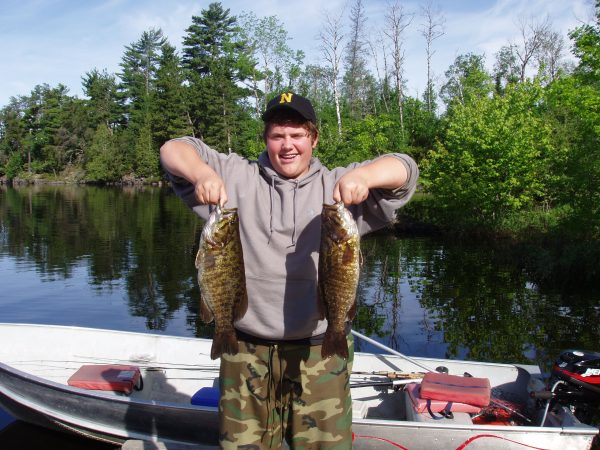
When most people think about freshwater fly fishing it brings to mind trout in a stream or maybe blue gills among the lily pads. This article is about fly fishing for bass! There is nothing better than catching an 18-inch smallmouth on a top-water flyrod popper. (See video titled “Bass on a Flyrod” in this website above)
In the Boundary Canoe Waters, where Little Eva Lake sits, most of the waters are open with very little brush or cover. This is a perfect habitat for smallmouth bass and most of the area lakes are full of them. It is also perfect for fly fishing when you don’t always have heavy tackle to keep your fish out of brush and other hazards.
You don’t need a heavy fly-rod for bass but you might have to move up a step or two from your average trout rod. I like a #6 rod with a weight-forward floating line. (#6 WF-F) Remember, these are not spooky trout, these are big aggressive smallmouth bass so you don’t need a stealthy presentation. I like a simple store-bought 5X tapered leader that tapers down to about 3 lbs on the end and I like a Styrofoam or cork popper with about ½ inch in diameter and ¾ inch long body with a buck hair tail. If your popper is larger or smaller you may need to adjust the leader some so the line lays out easily when you cast.
Where you find these bass depends upon the time of year. In all cases you prefer calm wind conditions and, as with most fishing, it is best just before dusk or just after dawn.
In the spring, these bass will be up in the shallows next to rocky shorelines. Look for shores where the bottom drops off gradually as you move away from shore as this is where they like to spawn. You will want to land your popper as close to the shore as possible, then pop it once or twice and let it sit for a while. These fish will be very aggressive and often hit with a big splash as soon as the popper lands. You will find them here throughout June until the water temperature starts to get above 63˚ F or so. Remember, these bigger fish are usually spawning females so handle them carefully for a successful release.
In the summertime, as the water warms up, you need to change your method to find the bass. The shallow sloped shores will no longer hold the fish because the water is too warm. They still like being around the rocky shores but they want deeper water where it is cooler. Here you need to look for shorelines that drop off more steeply to allow the fish to stay near the rocks but be in the deeper cool water. You also need to slow down your presentation and work from the shore out a little farther. Throw the popper next to the rocks, give it a pop or two and then be patient. Let it sit for minute or so and then another small pop and wait some more. These fish may be 8 -16 feet down but hey will come up. Unlike the spring fishing, these non-spawning bass are less aggressive and so the strike is usually much lighter. Quite often they will ease up below the popper and simply suck it into their mouth hardly making a sound or ripple. Prompting a strike in the summertime midday hours will be more difficult than other seasons.
In the fall, the top water fishing can pick up again but there are fewer calm days this time of year so like summer time, you may be limited to dusk and dawn hours when the wind dies down. As the nights start getting cooler the surface water tends to cool at night and this eventually triggers the fish to come up from the deeper water some. The fall flyrod top-water fishing method is much like the summertime but the action can be a bit faster. Still, you want to work slower than the spring spawn time. Look for those cool evenings when the air is cooler than the water temperature a couple hours before sunset.
As a bonus, our lake, like most in this area, has a large population of mooneyes. In the fall on those evenings where the air cools below the water temperature, the few surviving bugs will be attracted to the warmth of water. As these bugs hit the water surface, the mooneyes will be picking them off all over the lake. You will soon come to recognize their small splash as they feed on these bugs. They have very small mouths so you will need to put on a small floating bug or small rubber spider and just toss it out among these small splashes. They are not good to eat but they fight hard and are a blast to catch on a flyrod.